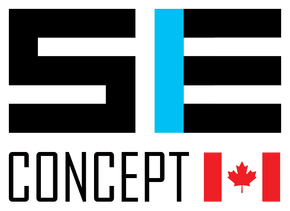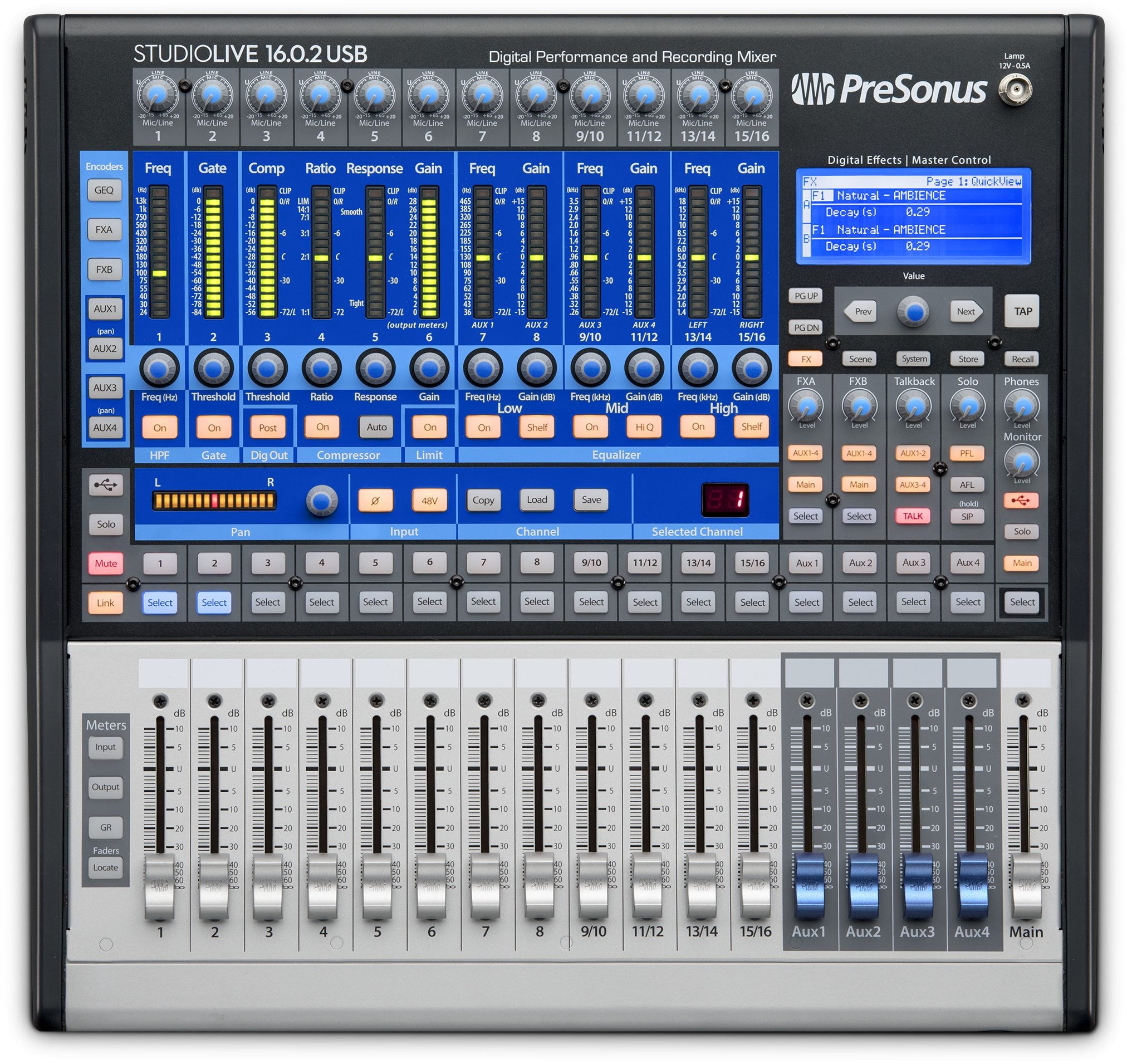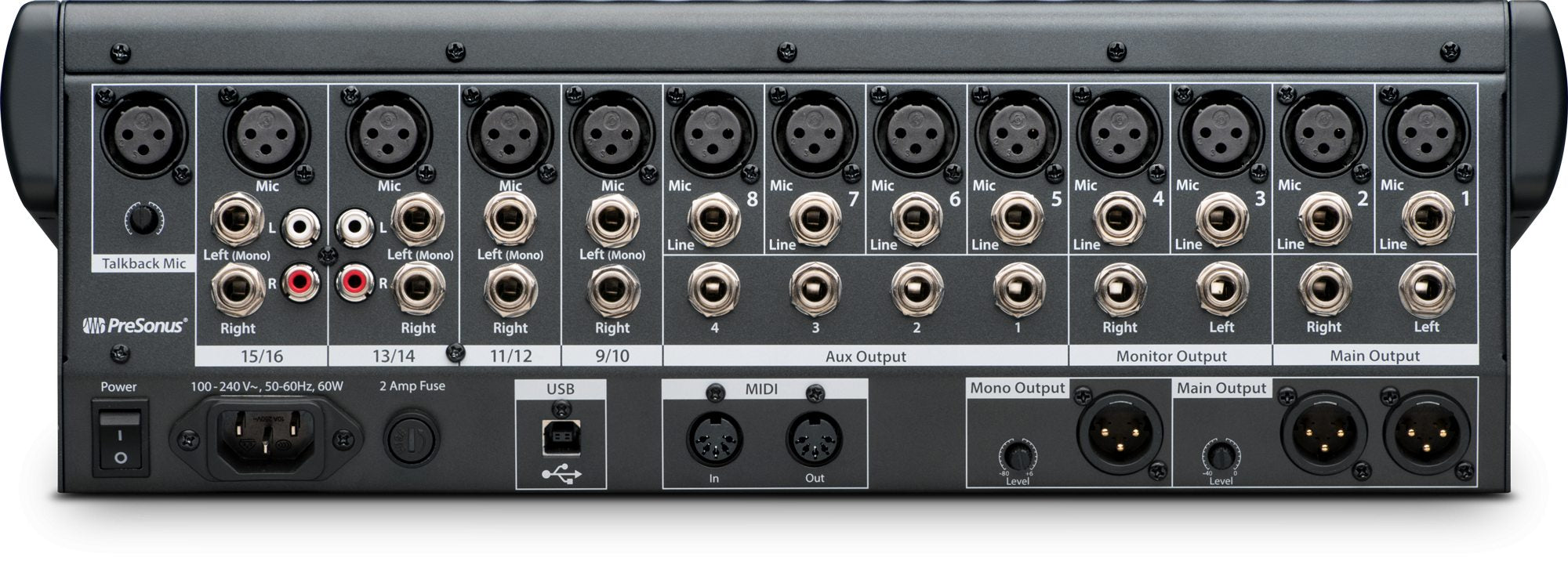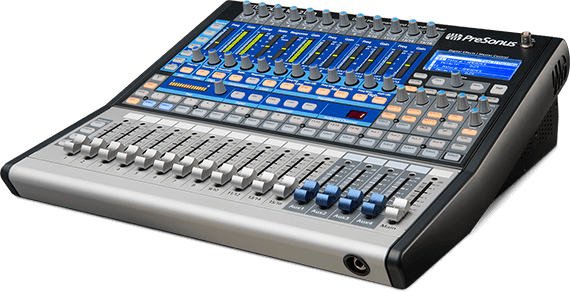Description
The ease of analog meets the power of digital.
When you’re mixing a live event or have an artist in the studio, you need to be able to work quickly. The StudioLive® 16.0.2 USB’s familiar, easy-to-use interface keeps all critical controls visible and accessible —not buried in menus or layers. Our design philosophy is simple: One fader for every mono or stereo channel; one output for every bus. Add to that easily accessed, color-coded function buttons; rotary trim controls; and clearly labeled, individual knobs for EQ and dynamics processing. Aux sends have their own physical controls. Every channel has a big, bright meter display. But don’t let the analog feel fool you: The StudioLive 16.0.2 USB offers the power of modern digital mixing, multitrack recording, wireless remote control, and more.
Small size. Bigger possibilities.
In a footprint of less than 2 square feet (0.19 square meters), the compact, 16-channel StudioLive 16.0.2 USB offers 8 mono input channels, 4 stereo channels, and 4 aux buses, each with a high-quality, 60 mm fader. You get generous analog I/O, 12 XMAX Class A solid-state mic preamps, a Talkback input with Class A mic preamp, extensive signal processing with physical controls, MIDI control, accurate metering, and a built-in multichannel recording interface. As with all StudioLive mixers, the 16.0.2 USB comes with a suite of tightly integrated recording, control, and audio analysis software. And it’s so lightweight and compact that you can easily hold it in one hand and tuck it under your arm.

You’ll never run out of signal processors.
StudioLive 16.0.2 USB mixers provide plenty of DSP power, with no limitations, no shared resources, no figuring out what processing is available where. You have all of the processing available at all times, with no compromises or caveats. The unique Fat Channel provides a compressor, limiter, expander, and 3-band semi-parametric EQ on every channel and bus; a highpass filter on each channel; phase reverse for the channel mic preamps; a library of professionally crafted presets; and the ability to save and selectively recall processor settings. A stereo, 31-band graphic EQ sits on the main bus. To top it off, you get two 32-bit delay/reverb effects processors, each with its own dedicated mix bus and a library of useful effects presets.
Superior sound.
Connect a StudioLive 16.0.2 USB mixer and you’ll instantly hear details and clarity you’d expect to find only in a much more expensive console. StudioLive mixers operate at up to 48 kHz for high-definition mixing and recording. High-quality Burr-Brown converters on every input and output provide a best-in-class 118 dB of dynamic range so you’ll catch every high and low with great accuracy and no audible distortion. And our XMAX microphone preamps deliver incredibly high headroom, deep lows, smooth highs, and a rich overall sound.
Recording is in StudioLive 16.0.2 USB’s DNA.
The StudioLive 16.0.2 USB’s built-in 18x16 multitrack recording interface is tightly integrated with the rest of the mixer—not an afterthought we tacked on. All 16 channels and the main mix continuously stream to your USB-connected Mac or Windows PC. Each channel can independently access its analog input or its dedicated digital return from your computer. And with StudioLive mixers, recording is simple and easy: Just launch the included, preconfigured Capture software for one-click recording of all channel inputs and your main mix. Or record with the included studio one artist DAW—or any recording software that supports ASIO or Core Audio. Now you can record in the studio or at the gig with equal ease.
Integrated, multiplatform software for flexible control and one-click recording.
Like all PreSonus StudioLive mixers, the StudioLive 16.0.2 USB is tightly integrated with an entire suite of state-of-the-art software. Mix wirelessly or over a wired network from anywhere using uc surface touch-control software for Mac, Windows, Android™, and iPad®. Control individual monitor mixes onstage with QMix®-UC for iPhone®/iPod® touch and Android™. Automate virtual soundchecks and record shows with capture for Mac and Windows. Edit, sweeten, and digitally release your recordings with studio one artist. StudioLive 16.0.2 USB mixers and software work together to form a cohesive ecosystem that helps you achieve your creative vision.
Dedicated analog connections for predictable signal flow.
Take a look at back panel of a StudioLive 16.0.2 USB mixer, and you’ll find the robust connections you’d expect from an analog mixer: balanced mic inputs on each of the 8 mono channels; 8 balanced ¼-inch line inputs; 4 unbalanced RCA line inputs; and dedicated balanced outputs for each of the 4 aux buses and the main stereo bus. Every input channel and bus send has its own dedicated jack—no sharing, no compromises—so you always know what’s flowing from each output.
8 mono mic/line channel inputs, each with:
- High-headroom Class A XMAX mic preamplifier
- XLR mic and balanced ¼-inch line inputs
- 60 mm precision fader
4 stereo line channel inputs, with:
- High-headroom Class A XMAX mic preamplifier (Ch. 9, 11, 13, and 15)
- XLR mic inputs (Ch. 9, 11, 13, and 15)
- Balanced ¼-inch line inputs (Ch. 9-16)
- Unbalanced RCA line inputs (Ch. 13-16)
- 60 mm precision fader (4 stereo)
- 4 Auxiliary buses (pre/post-fader send)
2 Internal FX buses
2 stereo 32-bit digital effects processors with customizable reverb and delay presets
Fat Channel signal processing on all channels and buses, with:
- 3-band semi-parametric EQ (individual band on/off)
- Full-featured compressor
- Standard downward expander
- Limiter
- Phase reverse (12 mic preamplifiers only)
- Pan with dedicated 15-LED display
- Stereo link for input channels and aux buses
- Highpass filter
One 31-band stereo graphic EQ (on main outputs only)
18-in/16-out USB recording interface (24-bit/44.1 kHz and 48 kHz)
- Compatible with most audio software via ASIO, Windows Audio, Core Audio
Scene store and recall
Settings can be copied among channels and buses and saved as user presets.
Software bundle includes:
- PreSonus® Studio One® Artist digital audio workstation for Mac® and Windows ®
- PreSonus Capture™ live-recording software for Mac and Windows
- PreSonus UC Surface mixer-control software for Mac, Windows, Android™, and iPad®
- Free downloadable PreSonus QMix®-UC software for iPhone®/iPod touch® and Android™ provides wireless remote control of aux mixes
Lockout mode protects your settings from meddlers and accidents
MIDI Control Mode provides control over:
- Scene and FX Preset recall
- Main Volume, FXA, and FXB output levels
- FXA and FXB assign/unassign to Mains
Computer system requirements:
Below are the minimum computer-system requirements for UC Surface, QMix-UC, and Studio One®.
Mac
- macOS® 10.11 or higher (64-bit only)
- Intel® Core™ 2 Duo processor (Intel Core i3 or faster recommended)
- 4 GB RAM (8 GB or more recommended)
Windows
- Windows® 7 x64 SP1 + platform update, Windows 8.1 x64, Windows 10 x64
- Intel Core 2 Duo (Intel Core i3 or faster recommended)
- 4 GB RAM (8 GB or more recommended)
Mac and Windows Systems
- USB 2.0 port
- Internet connection
- Internal or external 7200 RPM storage drive highly recommended
- 30 GB hard disk space
- Monitor with 1366x768 resolution
iOS
- iOS 10 or later
- iPad Pro, iPad Air 2, iPad Air, iPad mini 4, iPad mini with Retina display, iPad (4th generation)
Android
- Android™ 5.0 (Lollipop) or later
- Android smartphone (QMix-UC)
- Android tablet (8-inch) with 1024x768 resolution (UC Surface)
Note: The minimum system requirements may differ for DAWs other than Studio One. Please check the requirements for your DAW of choice with its manufacturer.
Note that the speed of your processor, amount of RAM and size and speed of your hard drive will greatly affect the overall performance of your recording system. Also, a more powerful system (faster processor with more RAM) will allow for lower latency (signal delay) than you might experience while monitoring audio signals.


VST is a registered trademark of Steinberg Media Technologies GmbH
ASIO is a trademark and software of Steinberg Media Technologies GmbH
Technical Specifications
Microphone Preamp |
|
|---|---|
| Type | XLR Female, Balanced |
| Frequency Response to Direct Output (at unity gain) | 20 Hz-20 kHz, 0 / -0.5 dBu |
| Frequency Response to Main Output (at unity gain) | 20 Hz-20 kHz, ±0.5 dBu |
| Input Impedance (Balanced) | 1 kΩ |
| THD to Direct Output (1 kHz at unity gain) | <0.005%, +4 dBu, 20 Hz–20 kHz, unity gain, unwtd |
| THD to Main Output (1 kHz at unity gain) | 0.005%, +4 dBu, 20 Hz-20 kHz, unity gain, unwtd |
| EIN to Direct Output | +125 dB unwtd, +130 dB A-wtd |
| S/N Ratio to Direct Output (Ref = +4 dB, 20 kHz BW, unity gain, A-wtd) | -102 dB |
| S/N Ratio to Main Output (Ref = +4 dB, 20 kHz BW, unity gain, A-wtd) | -95 dB |
| Common Mode Rejection Ratio (1 kHz at unity gain) | +65 dB |
| Gain Control Range (± 1 dB) | -16 dB to +67 dB |
| Maximum Input Level (unity gain) | +16 dBu |
| Phantom Power (± 2 VDC) | +48 VDC |
Line Inputs, Balanced |
|
|---|---|
| Type | ¼" TRS Female, balanced mono |
| Frequency Response to Direct Outputs (at unity gain) | 10 Hz-20 kHz, 0 / -0.5 dBu |
| Frequency Response to Main Outputs (at unity gain) | 20 Hz-20 kHz, 0/-0.5 dBu |
| Input Impedance | 10 kΩ |
| THD to Direct Output (1 kHz at unity gain) | <0.0007%, +4 dBu, 20 Hz-20 kHz, unity gain, unwtd |
| THD to Main Output (1 kHz at unity gain) | <0.005%, +4 dBu, 20 Hz-20 kHz, unity gain, unwtd |
| S/N Ratio to Direct Output (Ref = +4 dBu, 20 kHz BW, unity gain, A-wtd) | -105 dB |
| S/N Ratio to Main Output (Ref = +4 dBu, 20 kHz BW, unity gain, A-wtd) | -95 dB |
| Gain Control Range (± 1 dB) | -20 dB to +20 dB |
| Maximum Input level (unity gain) | +22 dBu |
Line Inputs, Unbalanced |
|
|---|---|
| Type | RCA Female, unbalanced (stereo pair) |
| Maximum Input Level | +22 dBu |
Main Outputs |
|
|---|---|
| Type | XLR Male, balanced (stereo pair); ¼” TRS Female, balanced (stereo pair) |
| Rated Output Level | +24 dBu |
| Output Impedance | 100Ω |
Aux Outputs |
|
|---|---|
| Type | ¼” TRS Female, balanced (mono) |
| Rated Output Level | +18 dBu |
| Output Impedance | 100Ω |
Monitor Outputs |
|
|---|---|
| Type | ¼” TRS Female, balanced (stereo pair) |
| Rated Output Level z | +18 dBu |
| Output Impedance | 100Ω |
System Crosstalk |
|
|---|---|
| Input to Output (Ref = +4 dBu, 20 Hz-20 kHz, unwtd) | -90 dBu |
| Adjacent Channels (Ref = +4 dBu, 20 Hz-20 kHz, unwtd) | -87 dBu |
Noise Gate (Expander) |
|
|---|---|
| Threshold Range | -84 dB to 0 dB |
| Attack Time | Adaptive (0.2 - 2.5 ms) |
| Release Time | 70 ms |
| Expander Attenuation Range | 2:1 |
Compressor |
|
|---|---|
| Threshold Range | -56 dB to 0 dB |
| Ratio | 1:1 to 14:1 |
| Response Time (Attack/Release | 0.2 ms / 1.0s (“Tight”) to 180 ms / 1.0s (“Smooth”) |
| Auto Attack and Release | Attack = 10 ms, Release = 150 ms |
| Curve Types | hard and soft knee |
EQ |
|
|---|---|
| Type | 2nd-order shelving filter (Q = 0.55) |
| Low (Low-pass or Bandpass) | 36 to 465 Hz, ±15 dB |
| Mid | 260 Hz to 3.5 kHz, ±15 dB |
| High (High-pass or Bandpass) | 1.4 kHz to 18 kHz, ±15 dB |
Digital Audio |
|
|---|---|
| Host Interface | USB 2.0 |
| ADC Dynamic Range (A-wtd, 48 kHz) | 118 dB |
| DAC Dynamic Range (A-wtd, 48 kHz) | 118 dB |
| Internal Processing | 32-bit, floating point |
| Sampling Rate | 44.1, 48 kHz |
| A/D/A Bit Depth | 24 bits |
| Reference Level for 0 dBFS | +18 dBu |
Clock |
|
|---|---|
| Jitter | <20 ps rms (20 Hz - 20 kHz) |
| Jitter Attenuation | >60 dB (1 ns in ≈ 1 ps out) |
Power |
|
|---|---|
| Connector | IEC |
| Input-Voltage Range | 100 to 240 VAC (factory-configured for country of destination) |
| Power Requirements (continuous) | 100W |
Physical |
|
|---|---|
| Length | 15.56 inches (397 mm) |
| Width | 16 inches (406 mm) |
| Maximum Height | 5.5 inches (140 mm) |
| Weight | 20 lbs. |
Estimate shipping
Refund Policy
We have a 30-day return policy, which means you have 30 days after receiving your item to request a return.
To be eligible for a return, your item must be in the same condition that you received it, unused, with all accessories and in its original packaging. You’ll also need the receipt or proof of purchase.
To start a return, you can contact us at boutique@seconcept.com. If your return is accepted, we’ll send you a return shipping label (at your expenses) as well as instructions on how and where to send your package back. Items sent back to us without first requesting a return will not be accepted and not refunded.
You can always contact us for any questions prior to purchase by email at: boutique@seconcept.com.
Damages and issues
Please inspect your order upon reception and contact us immediately if the item is defective, damaged or if you receive the wrong item, so that we can evaluate the issue and make it right.
Exceptions / non-returnable items
All Returns must contain all associated packaging and materials (ie accessories, manuals, wires, etc). Merchandise that is not returned in brand-new condition, including damages, abuse, marks, showing wear, or with missing packaging or accessories, will be subject to additional charges. Shipping and Handling charges (delivery and return) are non-refundable, including any shipping fees not directly incurred that are part of a free shipping promotion. Any items packaged with software, including but not limited to, DJ Controllers, Audio Interfaces, etc., must be returned with the original software disc including serial number and proof of deactivation.
We cannot accept returns on liquidation, special orders, liquid, needles, parts, used, sales, open box item or gift cards.
Exchanges
The fastest way to ensure you get what you want is to return the item you have, and once the return is accepted, make a separate purchase for the new item.
Refunds
We will notify you once we’ve received and inspected your return, and let you know if the refund was approved or not. If approved, you’ll be automatically refunded on your original payment method. Please remember it can take some time for your bank or credit card company to process and post the refund too.






